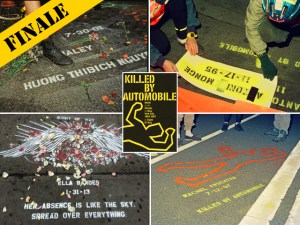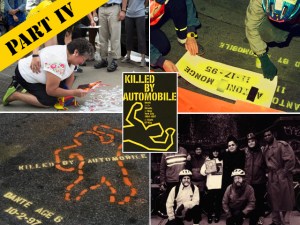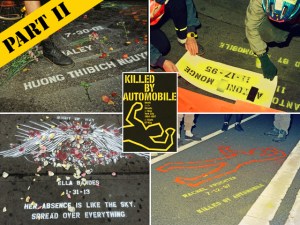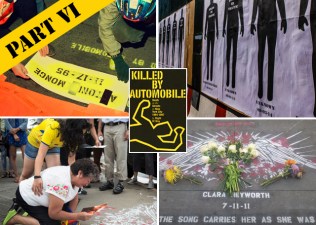The History of a Movement, Part III: The Death of Dante Curry
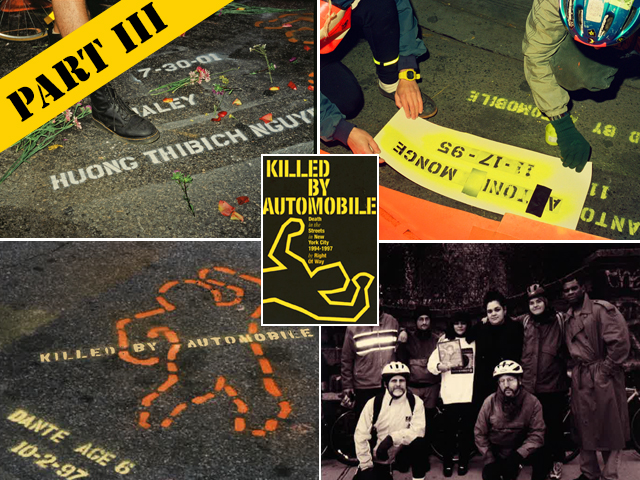
Amid the bloodiest year in Mayor de Blasio’s Vision Zero, Streetsblog continues its seven-part series focusing on a key strand in the movement for livable safe streets, written by a central figure in that movement, Charles Komanoff. A former head of Transportation Alternatives, Komanoff 25 years ago launched a highly effective public awareness campaign calling out the daily carnage on New York City streets. Under the name “Right Of Way,” his group brought the brutal reality of pedestrian and cyclist deaths to the public eye in the form of high-visibility street actions (including one arrest). Part I opened with the first “Killed by Automobile” stenciling in December 1996. Part II focused on how the movement began to generate press coverage.

If Rachel Fruchter’s death in Prospect Park in the summer of 1997 shook the safe-streets movement like an earthquake (see Part II of this series), the death of Dante Curry in the South Bronx that fall was a slow-detonating bomb.
With school closed for Yom Kippur, Dante, age 6, was being minded by his stepfather on a quiet side street in the South Bronx near Bruckner Boulevard. Feeling menaced by a neighbor’s dog, he ran onto Wales Avenue just as Jacob Rivera of Newark, N.J., age 26, was gunning his Mustang up the broad straightaway. Dante was flung 40 feet in the air — the police report said Rivera was doing 65. He died from head injuries at Lincoln Hospital.

We learned this a year later, when Dante’s Aunt Gladys called and asked if Right Of Way could make a memorial stencil. She had seen us in a TV clip about deadly New York City traffic. The database we were building from DMV records revealed seven other Bronx kids recently killed by drivers, including Crystal Vargas, 7, rammed off her bike in nearby Longwood, and Edward Hernandez, also 7, struck near Mosholu Parkway.
“Flatso” wouldn’t do for these children — the image was too jagged and too tall. We cut a rounder, softer, smaller stencil. On a chilly Saturday morning just before Christmas, 1998, a half-dozen of us met up at the Madison Avenue Bridge. Spray-painting gear in tow, flowers in hand, we crossed the Harlem River into the Bronx.
Our first stop was Wales Avenue. Waiting there, on the barren block in front of the cold, stolid Catholic Church, were Gladys and her sister, Evelyn Cancel, bearing a photo of Dante, her son. We exchanged tender hellos and set to work.
This was our first time memorializing a child and our first time stenciling with family. Two years in, after marking a hundred streets with strangers’ names and body outlines, we were making a memorial to someone with whom we had, through his mother and aunt, a tangible, almost intimate connection. A child.
It’s difficult to describe the strong currents of feeling that filled the air. Stenciler Michael Smith, a veritable Tom Paine of the anti-car cause, was also a father, with a son and daughter. My 4-year-old son now had a baby brother. My upstairs neighbor, Damon, who came to take pictures, had a toddler son as well. We knew the fragility, the preciousness.
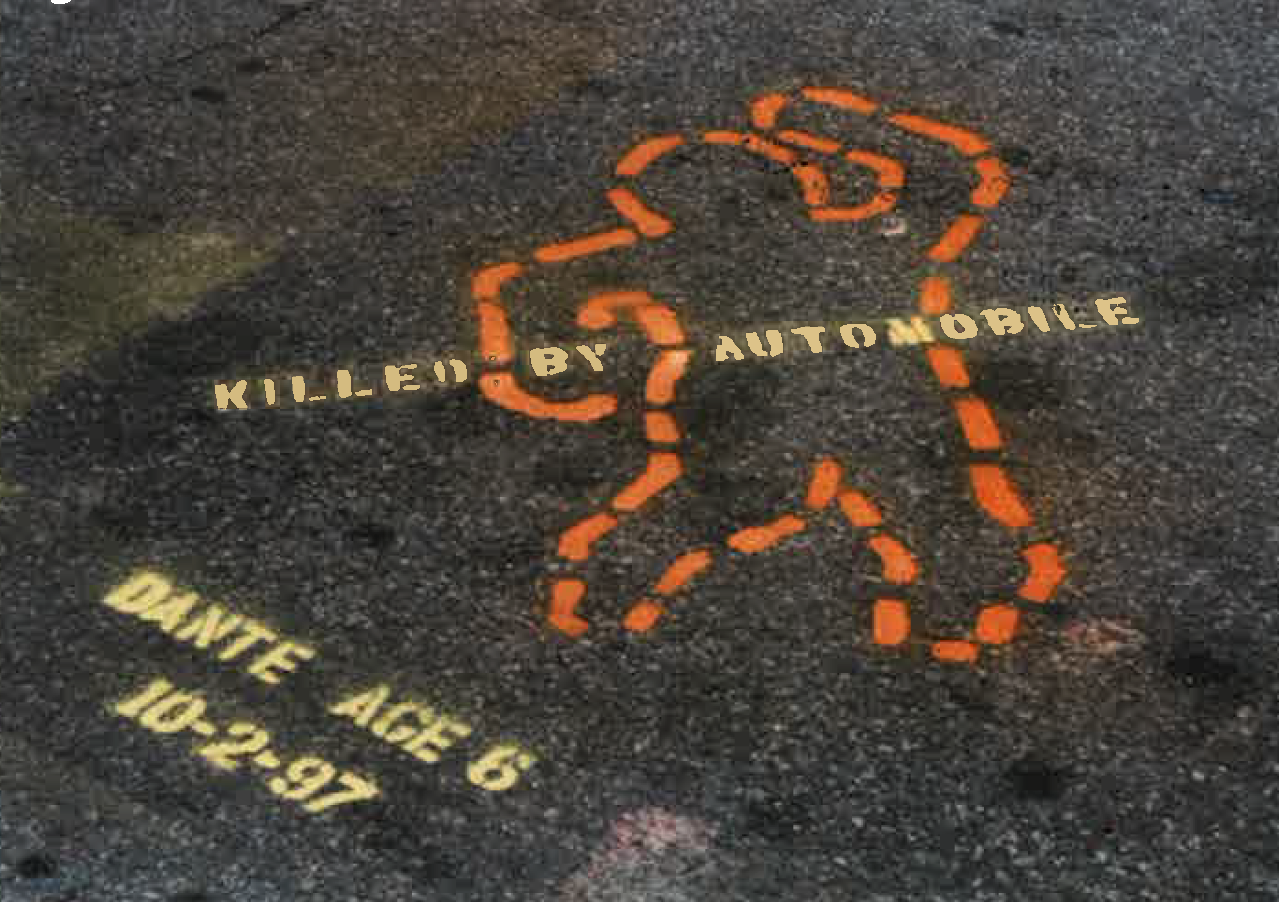
Dante Curry would have turned 30 last winter. Sammy Eckstein-Cohen would be 21, had a van driver not run him over on Prospect Park West in 2013, a few weeks before his bar mitzvah. Sammy’s death, and the death that same week of 4-year-old Allison Liao, killed when a cab driver smashed into her and her grandmother in a marked crosswalk in Flushing, led to the creation of the anti-traffic violence support and advocacy group Families for Safe Streets (see Part VI of this history).
A similar dream stirred in us on the December 1998 day when we met Dante’s mom, Evelyn Cancel. An advocacy and support group for families sundered by traffic violence was a logical next step. Cancel would have been an ideal spearhead. She was fiery and passionate, bursting with mother wit and love. Her sorrow was unquenchable, but so was her conviction that everything about our streets had to change, starting with their speedway designs and anything-goes driver entitlements.
Alas, our band of activists, now called Right Of Way — a name conjured earlier that year by O.G. stenciler Carter Craft — simply didn’t command the resources needed to harness New York’s Evelyns. We had no staff, no budget, and little experience in the organizing required to mold bereaved families from different circumstances into an effective fighting force.

What we did have was our two-foot-high stack of printouts covering nearly every instance of traffic violence fatal to someone outside a motor vehicle in New York City in the four-year period 1994 through 1997: 880 people on foot plus 67 bicycle-riders — 947 in all.
The stack had the weight of grief. Dante was here, from 1997, alongside his killer Jacob Rivera. Likewise, Jie Zhang, whose final breath gave birth to her son Sam, in 1994, as we recounted in Part I, digitally paired with her killer Ibrahim Diokhane, from Brooklyn. A mere dozen days and six rows apart in our chronological database were Clyde Moss and Rosemary Brodie, both of whom were riding bikes in Manhattan in broad daylight in October 1996 when they were doored and run over by Mark Taliercio of Staten Island and Abraham Witt of the Bronx, respectively — a dyad of death that helped precipitate Right Of Way’s founding meeting the next month.
The data included: Name, age and address of victim and driver. Crash location, date, time and weather conditions. Vehicle make, model, year, weight and body type — though, crucially, passenger vehicles weren’t differentiated between sedans and light trucks, a category that included the emergent, extra-deadly body type known as sport utility vehicles. Also, DMV’s distillation of the driver’s and victim’s actions in the moments leading to the crash as recorded by the cops.
Over the course of 1998, 19 different Right Of Way volunteers transcribed the state DMV entries and NYPD “MV-104a” crash reports into a database whose 60 columns now held all publicly available information for each incident. In early 1999, the database would be the basis for our magnum opus and cri de coeur, Killed By Automobile.
This series will return on Monday with Part IV. To read prior stories, start with Part I, and follow the links.
